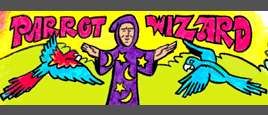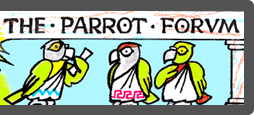Gail, I will try to give you a few facts every day as I read the book again. The info is on the tricahue but I think it's pretty safe to say that it applies to all the Patagonians because they are a sui generis species and they believe that the tricahue ended up in Chile from a single migration of a single flock from Argentina across the Andes so they are direct descendants of them.
Humans came to Chile 12,000 to 10,000 years ago but the Patagonian conures had already been there 40,000 years by the time they arrived.
They are called Loro Barranquero in Spanish and Burrowing Parrot in English from their habit of nesting in holes they dig out in cliffs (barranca in Spanish). The first historical reference of this species was made by Florian Baucke (Bauke or Pauke) a Silesian Jesuit who traveled to the Rio de la Plata region in mid 1700 and documented flora and fauna of the region but it was Juan Ignacio Molina, another Jesuit priest, naturalist and ornithologist, who named them Psittacus cyanoliseos, meaning faded blue parrot (from kyanos = blue and lysis = loose - they think that he might have confused the whitish spot on their chest to be pale blue instead) but the name was later changed by Charles Lucien Bonaparte, Napoleon's nephew and renown ornithologist, to Cyanoliseus patagonus in 1854. The nominate (nominate been the first species ever described and before they figured out there were subspecies) is Cyanoliseus patagonus patagonus (nominate species always repeat the second name to indicate they were the first one) and the subspecies are named for either the person who first described them (like 'bloxami for Andrew Bloxam) or the place where they are most common (Patagonus from Patagonia, Conlara from the River Conlara in Argentina, and Andinus from the Andes).
I am not going to go into their physical description because you already know what they look like, right?
It was also Abbe Molina who first described their habits back in the 1800's and described large flocks that were very destructive to cultivated fruits and grain fields and how they always posted a watch up on the trees when they went to ground to feed and how different birds took turns for this watch so they could all eat. He also mentions that the farmers would throw a hat up in the air to startle them and, when they all took flight, they would shoot them. I don't know if you can read Spanish but I am quoting his words:
"...produciendo gran daño a la fruta, y especialmente al grano. Vuelan en brigadas numerosas, y cuando descienden al suelo para comer, uno de ellos va a posarse sobre un árbol vecino para hacer la guardia, y avisar a los compañeros con gritos repetidos (…) se cambia de vez en cuando esta guardia, para que todos puedan comer”. Esta precaución de los loros hacía muy difícil cazarlos, aunque los cazadores se valían de una estratagema cual era lanzar un sombrero al aire, detrás del cual se lanzaba la bandada con increíble furia, y entonces con un escopetazo mataban una buena cantidad."
I got my hands on something written by Felix de Azara, a Spanish military and naturalist that lived in the Rio de la Plata region from 1781 to 1801 and who wrote a bit about these parrots so I will have more on this tomorrow.
In the meantime, something from the book I have:
They always choose, if at all possible, cliffs that face South for their 'loreras' (nests), this is because the temperature during the summer and the fluctuation of the same is much lower than if the cliff faces any other direction which would guarantee successful incubation of their eggs.
There are sightings of cliffs with over 1,000 nest openings on them but it doesn't mean that there are over 1,000 nests because although they can make nests with only one opening, they have found some that have up to five different entries. The openings are always oval in shape with the height(about 8 inches) been half of the width (about 16 inches)
The parents make a depression on the soil after they dig the nests into the face of the cliff and carefully clean it of all pebbles, rocks, etc until there is only a very thin and soft substrata of soil where they deposit between 2 and 5 eggs.
They don't sleep in the nests, they have more than one place where they sleep and regularly switch from one to another to confuse predators. Their favorite places are valleys (where they are protected from the harsh winds) with lots of 'quiscos' (
http://cactiguide.com/graphics/e_acida_e_600.jpg). These are tubular cacti that grow as tall as a tree and what they do is pull out the thorns on the very top of the 'branches' so they can safely perch there and sleep while leaving the 'body' of the cactus full of them in order to prevent the predators from climbing up to get them (sooo smart, right?) but they have adapted to human expansion and now also use electric wires for sleeping. There is one town called Monte Patria where over 1,300 individuals were observed perching on wires after an earthquake had tumbled down the cliff where they had their 'loreras' (nests).












